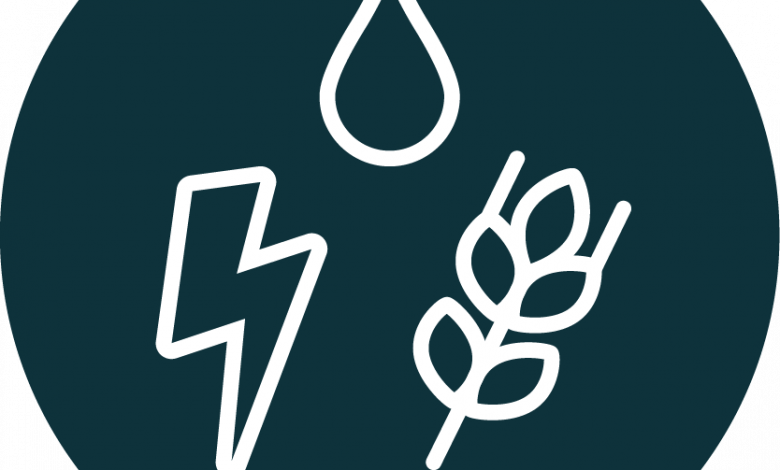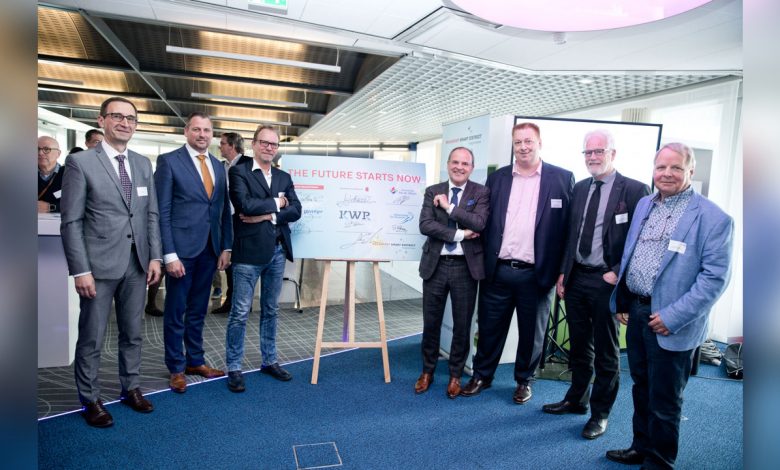Circular Water System Co-Creation in Brainport Smart District
Brainport Smart District (BSD) is an especially innovative district with about 1,500 homes and a business park of more than 12 hectares to be situated in Brandevoort, in the municipality of Helmond. This year the BSD partners began designing the district, which includes the process of co-creating the smart, circular and resilient water system. KWR is designing and coordinating this process together with experts from Brabant Water, the Aa and Maas and De Dommel Water Authorities, the Province of North Brabant, the municipality of Helmond and the Brainport Smart District Foundation.
The outcome of the phase to conclude at the end of September 2019 will be a report, which will present the district’s water-system ambitions and a menu containing bundles of possible measures and techniques to realise these ambitions.
Brainport Smart District
Brainport Smart District is a district with about 1,500 homes and a business park of more than 12 hectares, to be situated in Brandevoort in Helmond. This is where new insights and smart technologies are to be integrated to create a sustainable, social and attractive neighbourhood: a beautiful living environment in which residents can enjoy a high quality of life. A district for which various quadruple-helix partners (government, citizens, businesses and knowledge institutions) are setting the new standards for smart urban development.
Brainport Smart District is an example of a smart city that is not simply a sum of its separate parts, but one whose urban planning environment is being developed with the full integration of new transport, health, energy generation and storage, water provision and (circular) construction technologies. The residents are part of a new form of inclusive community in which they themselves play a key role in the development of their own living environment. The district will be a real-life living lab for the development of new systems, processes and services, which will also find applications in the redevelopment of other existing districts, in a manner that does not further burden, pollute and exhaust our planet.
For the water cycle partners (province, municipality, Water Authorities, water utilities), Brainport Smart District represents a unique opportunity to sit down with all the stakeholders, at a particularly early stage of the process, and jointly define the ambitions and objectives for a sustainable district with water as a structuring element. Water is a key component in the water-energy-food-climate nexus (the district’s metabolism), and is decisive in achieving the circularity and sustainability ambitions in the district. Water is also an element connecting other challenges, such as climate adaptation, the circular economy and the energy transition. In this context, smart direction and hydroinformatics can contribute significantly to realising and managing integrated solutions.

Water is a key component in the water-energy-food-climate nexus (the district’s metabolism), and is decisive in achieving the circularity and sustainability ambitions in the district.
Circular Water System Co-Creation
The exploratory phase of the co-creation process was completed in 2018. This phase’s objective was to identify the design principles and new solution perspectives for the Brainport Smart District water cycle and water system: a broad-based vision. The water cycle partners defined the design principles during the course of four co-creation workshops. The starting point was the vision described in the ‘Brainport Smart District Action Plan’ (PART A), the ‘Brainport Smart District Inspiration Book’ (PART B), and the ‘Nota Publiekrechtelijke kaders en Uitgangspunten’ (Public-Law Frameworks and Assumptions Document) (PART C). The results of the exploratory phase were contained in the ‘Brainport Smart District Circular Water System Background Document’ accompanying the ‘Memorandum of Understanding on the Brainport Smart District Circular Water System’. The MoU was signed in early 2019 by executives of the participating organisations, who thereby confirmed their support for the current co-creation process.
In 2019 the BSD partners have been designing the district, which includes a co-creation process of the water system. KWR is designing and coordinating this process, which involves three design teams:
- Climate Adaptation and Heat Stress;
- Circular Water System;
- Water Paragraph & Passports.
These design teams are made up of experts from the five water cycle partners and representatives of the residents, complemented as necessary by outside experts. Each design team meets for half a day every week to work on the BSD water system’s development. In seven co-creation plenary meetings (held once a month until the end of September), the core team oversees the project’s progress (handling divergences and convergences, producing prototypes on paper, and preparing the final report), integrates the results, and coordinates the alignment of the working groups.
Over the last few years co-creation processes have been increasingly used to respond to large societal questions, for which responses on an individual basis are no longer feasible. Co-creation offers solutions to questions that are characterised among others by their complexity, interdependence (thereby transcending organisational boundaries), the unpredictability of trends, and the need to be addressed with knowledge from multiple disciplines. Co-creation involves the participation of parties that are the knowledge owners with regard to the upcoming societal challenge; parties that moreover are engaged and willing to commit themselves to finding new solution perspectives.
The co-creation takes place in a ‘pre-competitive setting’. In other words, all knowledge and expertise is freely shared: both within and outside the group. One of the most important methodological starting points for such knowledge-inclusive co-creation is that it involves going through a learning cycle:
- building and defining questions and objectives;
- assessing and evaluating possibilities and solution paths;
- developing concepts and testing prototypes;
- observing, reflecting, evaluating and adjusting.
Co-creation is a people-oriented design process. It is centred on the delivery of ‘public value’. The approach is directed at knowledge development and the design of socio-technical solutions with attention for governance aspects, such as innovation in the area of the allocation of responsibilities, resources and risks. In this process there is transparency in the design criteria and stakeholders are given the opportunity to modify these. The co-creation process is iterative and adaptive (learning is central) as well as reflexive (facilitating reflection, including about the initial assumptions). Moreover, co-creation is action- and field-oriented: it is emphatically not a desk exercise. It involves pilots, but only as part of a broader transition process, in which techniques can be tested early on to then be further developed in line with locally acceptable solutions – in living labs for example.
Knowledge-inclusive co-creation takes account of the strategic triangle between the legitimation, authorisation and organisation/realisation of new solutions. Within co-creation processes, organised discussions take place at the executive, management and operational levels. If the technical experts design a solution that is incompatible with the existing power structures, institutional context, or allocation of resources and competences/authority, then the matter will be openly discussed and new allocations within a system solution sought.
Knowledge sharing
For Brainport Smart District we want to apply a new, complementary/reinforced model of co-creation, in which greater attention is paid to the (use of) the (local) knowledge system. Co-creation is strongly focused on the integration of objectives, policy fields, actors, areas and population groups. What we are adding here is an approach in which the knowledge of these players is also (explicitly) integrated and reinforced (through the science system). We do this with the KWR action-researchers who are embedded in the co-creation processes as reflective participants.

On 15 May, at Brainport Smart District (BSD) on the Automotive Campus in Helmond, Dragan Savic signed a Memorandum of Understanding together with Brabant Water, the Aa and Maas Water Authority, the De Dommel Water Authority, the Province of North Brabant, the municipality of Helmond, and BSD, to collaborate in this project.
Through the ‘Value in the Cycle’ theme of the Water in the Circular Economy (WiCE) initiative within the Joint Research Programme with the water utilities, as well as in the Water Knowledge Action Programme, knowledge and experience are being shared with water cycle stakeholders at various sites in the Netherlands (Boekel, Sneek, Oosterwold, Almere, Havenstad, Amsterdam and Superlocal Kerkrade). These partners want to learn from each other so as to accelerate innovation and avoid work duplication. For example: if the Zuiderzeeland voor Oosterwold Water Authority has already done the legal research to explore how it can continue meeting its mandate under new governance arrangements, in which the risks and responsibility are allocated differently, and if the WML water utility has investigated several business models for drinking water producers based on decentralised systems, why should the water cycle partners in Brabant not learn from them? This process dovetails perfectly with the Brainport Smart District living lab approach.
WiCE researchers are carrying out an analysis of the process and outcomes of the co-creation process with reference to the ‘Value in the Cycle’ theme (value creation, risk and responsibility allocation, actors’ roles), so as to assess the strategic relevance of Brainport Smart District for the drinking water utilities. This will be documented and discussed in a workshop.
Iterative design, with concrete results
Brainport Smart District is being organised in phases (between 2019 and 2028), with the later phases to be built upon lessons learned in the earlier ones. For this reason, a legal derogation request has been submitted for Brainport Smart District to make it possible for it to function as a living lab (pilot area). The proposed approach facilitates this learning process and the transaction in practice.
A co-creation process delivers concrete designs. At the same time, all innovative solutions are part of the learning cycle – after the realisation phase as well. This means that the three phases of a classic process are no longer so clearly distinguishable from each other. The approach is reflective and iterative, so that the learning, testing and improving are central.
The outcome of the phase to conclude at the end of September 2019 will be a report, which will present the district’s water-system ambitions, including the water cycle, and a menu containing bundles of possible measures and techniques to realise these ambitions. The ambitions will be translated into concrete objectives, and for each of these we will need indicators. This will enable a Quality Team to ultimately determine whether or not the options that the residents/businesses wish to pursue in the district are also compatible with the ambitions regarding water. A menu will be created to allow future residents/businesses to see what the options are. The menu contains a Baseline Option and a Plus Option.
These two options will be defined with targets connected to the indicators. The targets for the Baseline Option represent the minimum ambition level, while those of the Plus Option represent the maximum achievable ambition level. With the menu’s techniques and measures we show that the targets are indeed achievable, but we do not oblige the residents to adopt specific techniques. However, we can show what the impacts are of the different menu choices (bundles of measures and techniques). KWR is also creating a model of the Brainport Smart District water system in UWOT, to render the appraisals and impacts more comprehensible (optioneering).